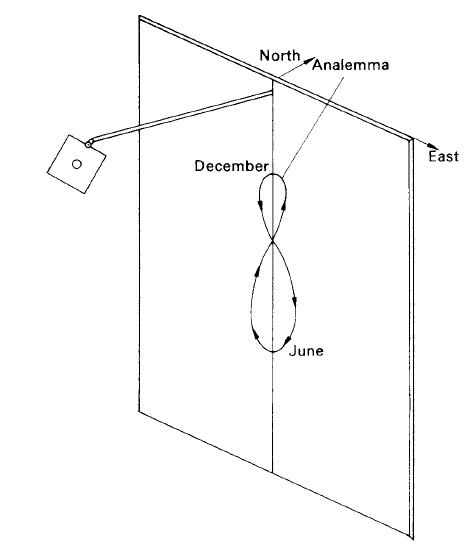
The Sun as a timekeeper: A noon-marker
 المؤلف:
A. Roy, D. Clarke
المؤلف:
A. Roy, D. Clarke
 المصدر:
Astronomy - Principles and Practice 4th ed
المصدر:
Astronomy - Principles and Practice 4th ed
 الجزء والصفحة:
p 405
الجزء والصفحة:
p 405
 4-9-2020
4-9-2020
 2045
2045
The Sun as a timekeeper: A noon-marker
The simplest noon-marker can be achieved by using a vertical plane which is oriented also in the east–west direction. By fixing a disc containing a small central hole on an arm which projects at right angles from the plane, during the hours close to mid-day a patch of light surrounded by a shadow will appear on the plane. It is an easy matter to mark on the plane the centre of the bright patch, corresponding to an image of the Sun.
If during the course of a year, at each noon the Sun’s position is noted, as expected the mark will rise and fall according to the noon altitude during the winter and summer. In addition, however, the marks move first eastwards and then westwards, repeating the excursions twice in the year, so producing a figure-of-eight pattern—the analemma. These departures from a vertical line correspond to the equation of time. On those days when the equation of time is zero, the Sun’s image at local noon

Figure 1. A simple noon-marker.
falls on the vertical line through the centre of the figure, whereas on those days when the departure from a line is greatest then the equation of time has its maximum value. This curve is an alternative way of displaying the equation of time. Its form is sometimes to be found on world maps or on globes. Using a simple device similar to that depicted in figure 1, and after orienting it correctly in a similar manner as for the horizontal sundial, the analemma may be drawn during the course of a year and the variations of the equation of time deduced. Conversely, if the analemma has previously been drawn on to the vertical plane, the device may be used for announcing the passage of the local noon. Comparison with the civil time noon may be made after applying the correction for longitude.
 الاكثر قراءة في مواضيع عامة في علم الفلك
الاكثر قراءة في مواضيع عامة في علم الفلك
 اخر الاخبار
اخر الاخبار
اخبار العتبة العباسية المقدسة


